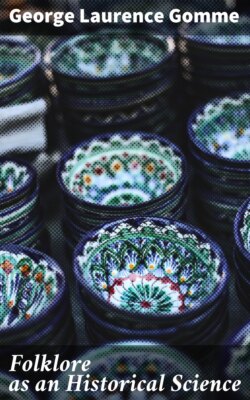Читать книгу Folklore as an Historical Science - George Laurence Gomme - Страница 18
На сайте Литреса книга снята с продажи.
XI.—Brother and Sister
Оглавление| Story radicals | Story accidentals | Added features | Modern gloss | |
| 1. Savage elements | Transformation of hero into roebuck after drinking at stream | — | — | — |
There are thus savage elements in seven out of twelve stories, and the question becomes an important one as to how this is. They are the stories of the nursery, told by mothers to children, stories kept alive by tradition, and the only possible answer to our question is that they contain fragments of the early culture-history of the ancestors, or at all events the predecessors, of those who have preserved them for our use. An occasional savage incident might have been considered a freak of the original narrator, or a borrowing by one of the countless late narrators of these stories brought home from savage countries; but statistics disprove both of these suppositions. It is not accidental but persistent savagery we meet with in the folk-tale. It is also the savagery to be found amongst modern peoples still in the savage stage of culture.
This is proved in a very complete manner by Mr. MacCulloch, whose study provides the material for a statistical survey of story incidents founded on primitive custom and belief.[110] They are the most ancient history to which we have access. That this history is contained in the folk-tales of modern peasantry shows it to have come from that far-off period which saw the earliest condition of these people. It is still history, if it tells us of a life which preceded the written record. It is history of the most valuable description, for it is to be found nowhere else as relating to the remotest period of European civilisation. The modern savage is better off in this respect. He has an outside historian in the traveller and the anthropologist of modern days. The savage who was ancestor to our own people had no such means of becoming known to history, or had but very limited means, and it is only in the deathless tradition that we can trace him out.
These conclusions have been drawn from that great class of tradition preserved by historic peoples in historic times, and yet unmistakably pointing to prehistoric culture. We have been able to show the methods to be adopted for, and the results of, disengaging the myth which has gravitated to the historic person or place from the historic facts which have become part of the legend, and to trace out in the folk-tale facts which belong to a culture far removed from civilised life. There are thus revealed two distinct centres of influence, the traditional centre and the historic centre, and it is obvious that the question must be asked—which is the more important? It seems to me equally obvious that the answer must be given in favour of the historic. History is indebted to tradition for preserving some of the most remote facts of racial or national life, which but for tradition would have been lost, and if we are content to use this tradition as a storehouse from which we may provide ourselves with ancient historical documents, we can trace out therefrom points in the history of any given country wherever the traditions have been preserved.
The folk-tale, in point of fact, equally with the personal and local legend, comes into close contact with history. The periods of history in the folk-tales are different from those in the legends, but together these periods reach from prehistoric culture to historic event. We cannot, however, call this extent of time a continuous period, and we cannot point to definite stages within the detached periods. Much more research must be accomplished before it will be possible to claim such results as these. I have indicated some points of difficulty, some methods of treatment which appear to me to be wrong, and to which I shall have again to refer later on; but in the meantime, from the necessarily incomplete evidence which I have been able to produce, it is, I think, abundantly clear that folklore has to be studied from its historical surroundings if we would draw from it all that it is capable of telling.
